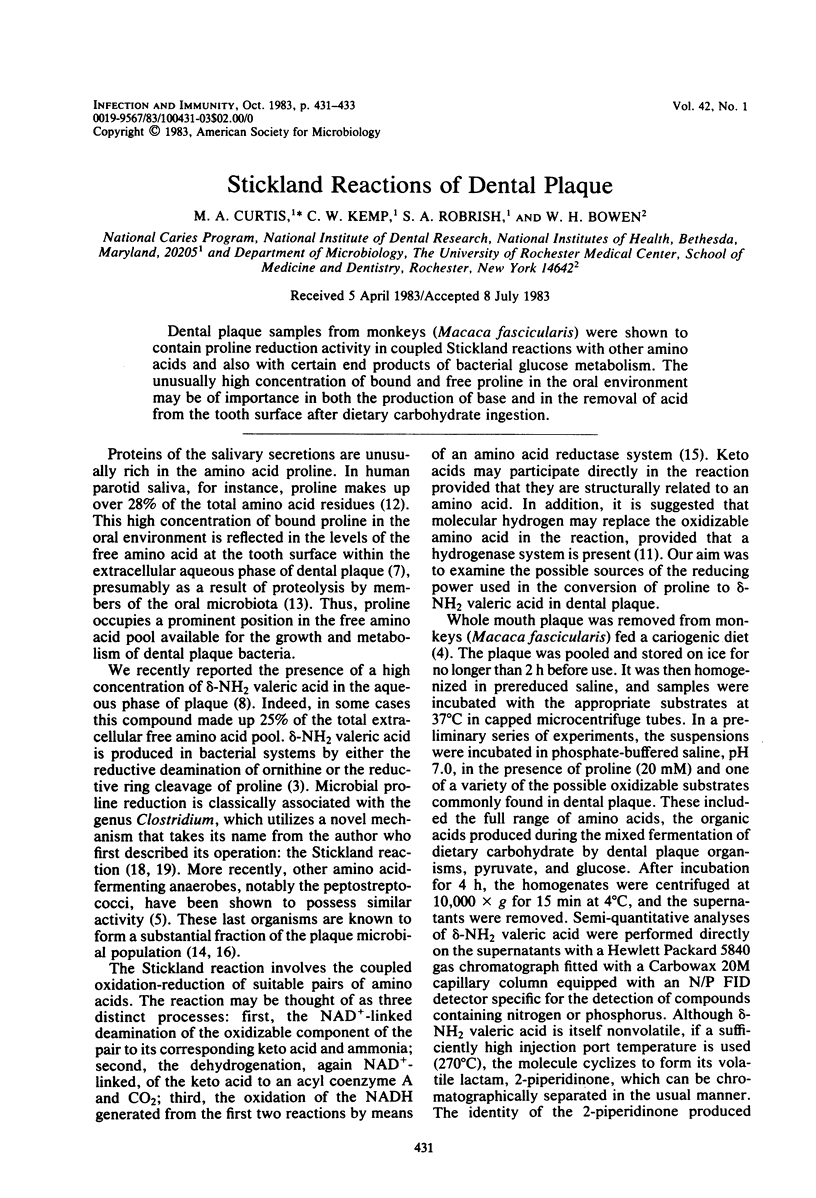Abstract
Dental plaque samples from monkeys (Macaca fascicularis) were shown to contain proline reduction activity in coupled Stickland reactions with other amino acids and also with certain end products of bacterial glucose metabolism. The unusually high concentration of bound and free proline in the oral environment may be of importance in both the production of base and in the removal of acid from the tooth surface after dietary carbohydrate ingestion.
Full text
PDF


Selected References
These references are in PubMed. This may not be the complete list of references from this article.
- BARD R. C., GUNSALUS I. C. Glucose metabolism of Clostridium perfringens: existence of metallo-aldolase. J Bacteriol. 1950 Mar;59(3):387–400. doi: 10.1128/jb.59.3.387-400.1950. [DOI] [PMC free article] [PubMed] [Google Scholar]
- Barbarash G. R., Quarles R. H. Single-column amino acid analysis with o-phthalaldehyde: an evaluation of two commercial buffer systems. Anal Biochem. 1982 Jan 1;119(1):177–184. doi: 10.1016/0003-2697(82)90683-2. [DOI] [PubMed] [Google Scholar]
- Bowen W. H. The induction of rampant dental caries in monkeys (Macaca irus). Caries Res. 1969;3(3):227–237. doi: 10.1159/000259597. [DOI] [PubMed] [Google Scholar]
- Britz M. L., Wilkinson R. G. Leucine dissimilation to isovaleric and isocaproic acids by cell suspensions of amino acid fermenting anaerobes: the Stickland reaction revisited. Can J Microbiol. 1982 Mar;28(3):291–300. doi: 10.1139/m82-043. [DOI] [PubMed] [Google Scholar]
- Cole M. F., Bowden G. H., Korts D. C., Bowen W. H. The effect of pyridoxine, phytate and invert sugar on production of plaque acids in situ in the monkey (M. fascicularis). Caries Res. 1978;12(4):190–201. doi: 10.1159/000260333. [DOI] [PubMed] [Google Scholar]
- Curtis M. A., Eastoe J. E. A preliminary investigation into the identity of a major ninhydrin-positive component of dental plaque fluid from the monkey Macaca fascicularis. Arch Oral Biol. 1978;23(5):421–423. doi: 10.1016/0003-9969(78)90102-4. [DOI] [PubMed] [Google Scholar]
- Curtis M. A., Eastoe J. E. Comparison of free amino acid pools in dental plaque fluid from monkeys (Macaca fascicularis) fed on high and low sugar diets. Arch Oral Biol. 1978;23(11):989–992. doi: 10.1016/0003-9969(78)90254-6. [DOI] [PubMed] [Google Scholar]
- Hoogerheide J. C., Kocholaty W. Metabolism of the strict anaerobes (genus: Clostridium): Reduction of amino-acids with gaseous hydrogen by suspensions of Cl. sporogenes. Biochem J. 1938 Jun;32(6):949–957. doi: 10.1042/bj0320949. [DOI] [PMC free article] [PubMed] [Google Scholar]
- Levine M. J., Ellison S. A. Immuno-electrophoretic and chemical analyses of human parotid saliva. Arch Oral Biol. 1973 Jul;18(7):839–853. doi: 10.1016/0003-9969(73)90054-x. [DOI] [PubMed] [Google Scholar]
- Mashimo P. A., Ellison S. A., Slots J. Microbial composition of monkey dental plaque (Macaca arctoides and Macaca fascicularis). Scand J Dent Res. 1979 Feb;87(1):24–31. doi: 10.1111/j.1600-0722.1979.tb01936.x. [DOI] [PubMed] [Google Scholar]
- Mäkinen K. K. Studies on oral enzymes. II. Fractionation and characterization of aminopeptidases in human dental plaque. Acta Odontol Scand. 1966 Dec;24(5):605–617. doi: 10.3109/00016356609028731. [DOI] [PubMed] [Google Scholar]
- NISMAN B. The Stickland reaction. Bacteriol Rev. 1954 Mar;18(1):16–42. doi: 10.1128/br.18.1.16-42.1954. [DOI] [PMC free article] [PubMed] [Google Scholar]
- Socransky S. S., Manganiello A. D., Propas D., Oram V., van Houte J. Bacteriological studies of developing supragingival dental plaque. J Periodontal Res. 1977 Mar;12(2):90–106. doi: 10.1111/j.1600-0765.1977.tb00112.x. [DOI] [PubMed] [Google Scholar]
- Somerville H. J. Enzymic studies on the biosynthesis of amino acids from lactate by peptostreptococcus elsdenii. Biochem J. 1968 Jun;108(1):107–119. doi: 10.1042/bj1080107. [DOI] [PMC free article] [PubMed] [Google Scholar]
- Stickland L. H. Studies in the metabolism of the strict anaerobes (Genus Clostridium): The reduction of proline by Cl. sporogenes. Biochem J. 1935 Feb;29(2):288–290. doi: 10.1042/bj0290288. [DOI] [PMC free article] [PubMed] [Google Scholar]
- Stickland L. H. Studies in the metabolism of the strict anaerobes (genus Clostridium): The chemical reactions by which Cl. sporogenes obtains its energy. Biochem J. 1934;28(5):1746–1759. doi: 10.1042/bj0281746. [DOI] [PMC free article] [PubMed] [Google Scholar]


